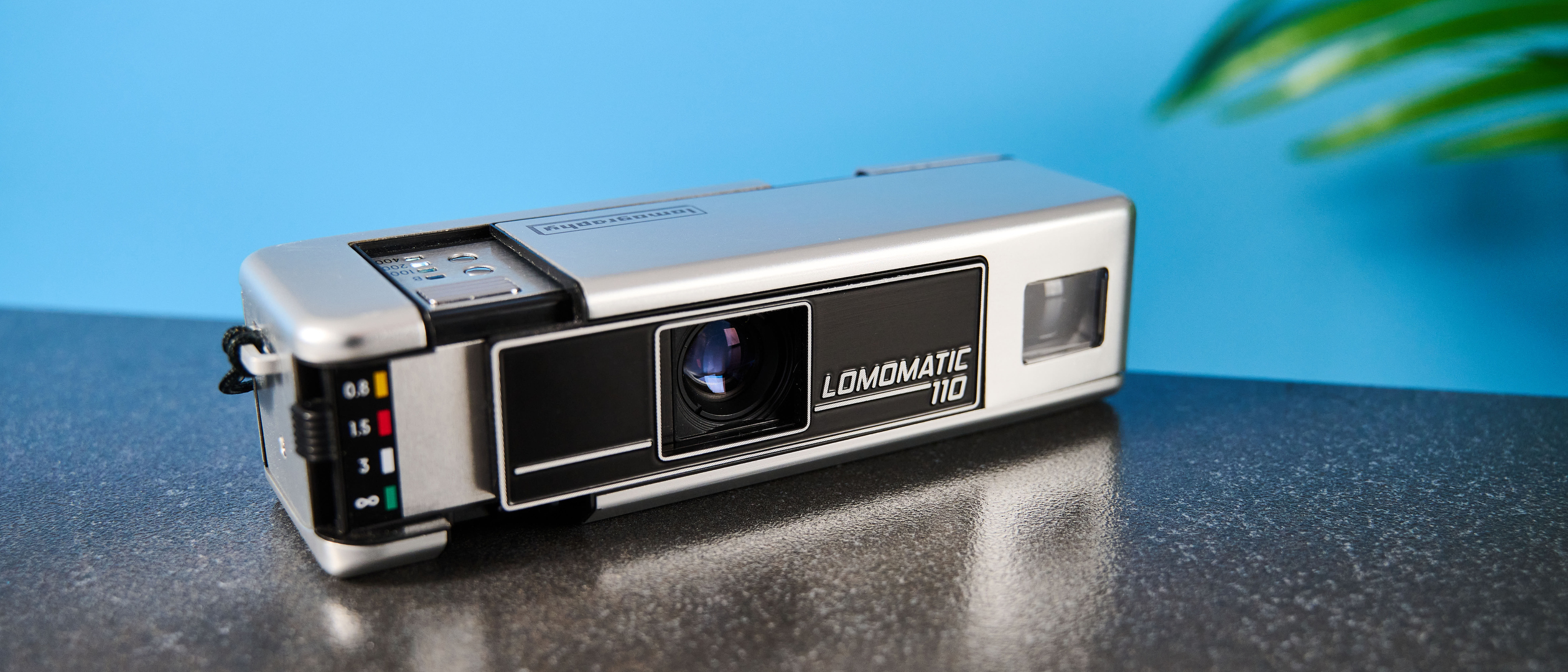Tom's Guide Verdict
The Lomography Lomomatic 110 film camera has an eye-catching design and is very easy to use. It’s built really well and its compact size means it’s perfect to travel with. But images are hit-or-miss, the film advance mechanism catches all the time, and film is expensive to buy and process.
Pros
- +
Eye-catching design
- +
Great build quality
- +
Easy to use
- +
Perfect for travel
Cons
- -
Results are hit-or-miss
- -
Film advance mechanism catches
- -
Expensive film and processing
Why you can trust Tom's Guide
If you’re a photography enthusiast or even a novice, you might be familiar with 35mm film cameras, but do you know about 110 film? It’s half the size of a 35mm film frame and not very accessible in terms of price and processing. So is the Lomography Lomomatic 110 still worth getting?
The Lomomatic 110 uses the 110 film format, which Lomography revived in 2012 — it’s an imperfect format as the smaller negative size means it has a lower resolution, so it’s intended for people who value artistic choices over the technical semantics of photography. The camera itself is built really well and is available in a few colorways, and it’s easy to use too. Its small form factor means it’s easy to travel with, and its design is unlike any we’ve seen on 35mm cameras. But I’d emphasize the word “imperfect” here as the results are hit-or-miss, the film advance mechanism isn’t flawless, and it’s expensive to buy and process film.
Is this one of the best cameras for you? For the complete breakdown, read my full Lomography Lomomatic 110 review.
Lomography Lomomatic 110 review: Specs
| Specs | Lomography Lomomatic 110 |
|---|---|
| Price | Starts at $99 / £89 |
| Focal length | 23mm Minitar CX glass |
| Viewfinder | Yes |
| Exposure control | Automatic |
| Shutter | 1/250 to 30s (Auto) | 30s (Bulb) |
| Aperture | f/2.8 or f/5.6 |
| Shooting range | Manual zone focusing, 0.8 m / 1.5 m / 3m / ∞ |
| Flash | Optional Lomomatic 110 flash |
| Self-timer | No |
| Power | 1 x CR2 battery |
| Dimensions | 4.4 x 1.73 x 1.37 inches |
| Weight | 3.98 ounces |
| Film format | 110 |
| Film development cost | $20 / £16 approx. |
Lomography Lomomatic 110 review: Cheat sheet
- What is it? An eye-catching film camera that uses 110 film
- Who is it for? For people who don’t mind imperfect photos and spending lots of money on film and processing
- How much does it cost? The Lomography Lomomatic 110 starts at $99 / £89 and goes all the way up to $189 / £169
- What do we like? The attractive design and great build quality, the compact size for travel, and ease of use
- What don’t we like? Results are hit-or-miss, the film advance mechanism catches frequently, and film is expensive to buy and process
Lomography Lomomatic 110 review: Price & availability

Launched earlier this year, the Lomography Lomomatic 110 is available for $99 / £89 without the flash unit. If you get it with the flash unit, the price jumps to $119 / £109. Alternatively, you can get the metal variant for $159 / £149 or the Bellagio model for $189 / £169. All of these are available on the Lomography website.
Lomography Lomomatic 110 review: Design & build quality

Reminiscent of 110 film cameras of ye olde, the Lomography Lomomatic 110 is a compact and pocketable camera, measuring 4.4 x 1.73 x 1.37 inches. I could easily slide it into my jeans or coat pocket — it’s smaller than your average chocolate bar and definitely smaller than most modern smartphones. It isn’t very heavy either, weighing just 3.98 ounces, which means you can comfortably hold it in one hand. I barely noticed its weight when it was in my pocket.
Available in a few colorways as I mentioned earlier, I tested the metal one which looks fantastic and is made of high-quality — you guessed it — metal. When I was testing the Lomomatic 110, I received multiple compliments as it looks unlike any other film camera I’ve used.
Lomography Lomomatic 110 review: Lens & viewfinder

The Lomography Lomomatic 110 is fitted with a 23mm Minitar CX glass lens, so it’s good for group shots and landscapes. The camera utilizes manual zone focusing, so you can set the focal length to 0.8 m / 1.5 m / 3m / ∞. Once you’ve done that, all you need to do is look through the viewfinder and shoot.

The viewfinder is located on the left-hand side, next to the film door. It’s small but comfortable to use, and, as someone who wears glasses all the time, I had no issues using it. Thankfully, it’s bigger than the Lomo’Instant Square Glass’ ($149) whose viewfinder was a pain to look through.
It’s important to note that the Lomomatic 110 doesn’t have a built-in flash. Instead, you’ll need to spend a little extra on the variant with the flash, which can then be attached next to the viewfinder.

You can choose the aperture too. There’s a dedicated Night and Day mode switch which lets you set the aperture to either f/2.8 for night or f/5.6 for day. The camera’s built-in light meter then calculates the shutter speed automatically, and this ranges from 30s to 1/125s.
Lomography Lomomatic 110 review: Controls

The Lomography Lomomatic 110 isn’t a difficult camera to use. There’s no physical button so to turn it on, pull it open and you’ll hear a very satisfying mechanical whirring and snap. It’s the most fun I’ve had powering up a device!

This is where you load the film too. Once you’ve pulled it open, a door swings open and you can pop a film roll in — it doesn’t get easier than that. To advance the film, you need to snap it shut. However, this mechanism isn’t flawless as in my testing, the door kept catching so I had to repeat the process until it shut completely. This proves to be quite frustrating when you have to do it over and over again.

Next to the shutter is a switch to change focal lengths. Pulling the camera open also reveals the controls. There’s a button to control the three ISO settings — 100, 200 and 400 — and a Bulb exposure button. The Bulb mode slows the shutter speed down to 30 seconds so you can use it to create long exposures and capture light trails, for example. Both are located right below the shutter button. Given the camera’s small form factor, the control scheme feels a little cluttered. The shutter button is quite recessed and there were a couple of instances where I pressed the Bulb button by mistake.
Flip the camera over and you’ll see two more controls: the Day/Night aperture and multiple exposure sliders. Like I said earlier, you can use the Day/Night slider to set the aperture to either f/5.6 or f/2.8.
Lomography Lomomatic 110 review: Image quality

Like with most film cameras, you can’t see the photos you’ve taken with the Lomography Lomomatic 110 until they come back from the lab — and that’s the exciting part of it. In the lead up to me receiving the digital copies, I kept thinking about what they’d look like. Results can be hit-or-miss, as with any film camera. The 110 film that the camera uses is half the size of a 35mm film frame, and the small negative size means it's difficult to enlarge successfully. Resulting images are, therefore, grainy and of a lower resolution. Having shot with 35mm film cameras, I’d recommend those over a 110 one.



The gallery above consists of some shots taken with the Lomomatic 110 in Day mode. The first photo of the air balloon in the distance is my favorite of the lot as I love the pop of red which the camera has captured very well. Similarly, the autumnal colors in the other photos have been reproduced well.


In gloomy conditions — which we encounter nearly every day in the U.K. — there’s a high probability of camera shake when shooting handheld, even if you’re shooting in Day mode during the day, as can be seen in the photos above. The shutter speed is set automatically and it looks like the camera is dropping shutter speed unnecessarily in bright conditions. It will take a bit of trial and error for you to figure out the best settings.



Another limitation of the Lomomatic 110 is that it can’t be mounted onto a tripod. This means that when you’re shooting in lower light, you’ll have to be really still but even then, the slightest movement will ruin the image. This is especially true when shooting in Bulb mode which drops the shutter speed to 30s.
In the gallery above, you can see a few examples of what photos look like when shot handheld with the aperture mode set to Night. I love the first photo of the lit candles and I feel like the camera has captured a lot of details, and the photo of the light trails looks great too. Imperfect photos like these would have done numbers on Tumblr in 2013, and they could still add a vintage and artistic aesthetic to your Instagram feed if that’s what you’re after.
Lomography Lomomatic 110 review: Film cost & yield

I used a roll of Color Tiger 110 ISO 200 film, which consists of 24 exposures, and this costs $17 at Amazon U.S. / £36 (3-pack) at Amazon U.K. In comparison, 35mm is more affordable, with one roll (36 exposures) costing $13 / £13.
On average, it costs approximately $20 to process a roll in the U.S. In the U.K., I couldn’t find a local store that could develop it for me so I had to post the film, and it cost me £16 (excluding postage). 35mm film is more affordable once again as, on average, it costs approximately $10 / £10.
Lomography Lomomatic 110 review: Verdict

So, should you buy the Lomography Lomomatic 110? There are a few things I love about this camera. Its design, for starters, is unique and unlike any I’ve seen before. It’s built really well too, and using it is quite straightforward. The small size means it should slip right into your pocket so you can take it traveling.
But its flaws are too jarring. Results are hit-or-miss, especially when shooting at night as you need an extremely steady hand or a flat surface as the camera can’t be mounted onto a tripod. The film advance mechanism, while fun, catches quite often and you have to repeat the process until you get it right. Given the fact that you can pick up a 35mm film camera, like the Kodak FunSaver 35mm, for $19, it’s hard to recommend the Lomomatic 110. Buying and processing film is more tedious and pricier.
If you like the photos I've used in this review, then it might be worth getting the Lomomatic 110. If not, get a 35mm camera instead.

Nikita is a Staff Writer on the Reviews team at Tom's Guide. She's a lifelong gaming and photography enthusiast, always on the lookout for the latest tech. Having worked as a Sub Editor and Writer for Canon EMEA, she has interviewed photographers from all over the world and working in different genres. When she’s not working, Nikita can usually be found sinking hours into RPGs on her PS5, flying a drone (she's a licensed drone pilot), at a concert, or watching F1. Her work has appeared in several publications including Motor Sport Magazine, NME, Marriott Bonvoy, The Independent, and Metro.

